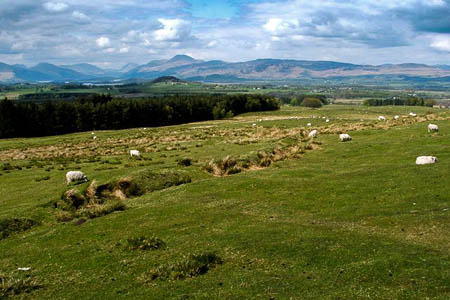The body representing mountaineers in Scotland has objected to plans for a windfarm just outside a national park.
The Mountaineering Council of Scotland said the proposed development in the Kilpatrick Hills would be visible from many of the most popular hills for walkers and climbers in the area.
The proposal is for 10 turbines at Merkins Farm near Balloch, and lies just 2km south of the Loch Lomond and the Trossachs national park boundary in the Kilpatrick Hills regional scenic area.
The mountaineering council said: “The MCofS has argued against the planning application because a wind farm in this location would be contrary to the purposes of its regional scenic area designation.
“It would seriously undermine the landscape quality of the regional scenic area and the setting of the national park. As such it would be contrary to adopted policies in the Glasgow and Clyde Valley structure plan, the West Dunbartonshire local plan and Scottish planning policy.
“The MCofS considers that the applicant’s assessment of the proposal significantly undervalues the importance of the landscape quality and character, which the West Dunbartonshire Council has a statutory duty to conserve.”
Chief officer David Gibson said: “If the application is approved, 10 white turbines on the skyline would welcome visitors to this internationally recognised scenic area at the main southern gateway of the national park.
“These would be visible from the popular hills around Loch Lomond and the Trossachs, such as The Cobbler, Ben Lomond, Ben Venue and Ben Ledi. This windfarm proposal is not in a suitable location and should not be supported by the West Dumbartonshire Council.”
Lomond Energy has applied to West Dumbartonshire Council to build the turbines, which would stand up to 120m tall 265m up the hillside and supply up to 25MW of power which, the company said, is enough to power up to 11,000 homes for a year.
The company admitted: “The proposed windfarm is located within the Kilpatrick Hills RSA and as such, there will be a significant impact on this locally designated landscape.
“Locally significant impacts from the Loch Lomond and Trossachs national park are also predicted, to 10km, but the impact on the park as a whole is predicted to be minor.
“No other significant impacts on designated landscapes are predicted. To assess likely impacts on visual amenity during operation of the proposed windfarm, 20 viewpoints were selected for detailed review; these were agreed in consultation with Scottish Natural Heritage, West Dunbartonshire Council, Stirling Council, Loch Lomond and the Trossachs national park and several other consultees.
“Of these 20 viewpoints, significant visual impacts are predicted for nine viewpoints, two with ‘major’ impacts and seven with ‘moderate’ impacts, and minor or negligible impacts are predicted for the remaining 11 viewpoints.”

Iain G Richmond
24 March 2012BALLAD O' THE WIND WARRIORS ( to the tune: 'Flower o' Scotland)
Oh hills o Scotland when will we see yer charm again
Without yon turbines that scar yer bonnie glens
That swarm amongst them for greedy business
And overwhelm us ,oor wee bit butts an' bens
Our shores are blighted wi' steel in great arrays
That turn and mock us and spoil the gentle waves
And as this happens smug Salmond's army
Our lovely Scotland they desecrate.
The time has come noo that we must gather and unite
Against these turbines and their plundering blight
So raise your voices , take up your pens
And help oor hillsides charm once again
Iain G Richmond
Ann Christie
13 April 2012I strongly oppose this
proposed wind farm development. The height of the turbines is ridiculous, not just because it is on the outskirts of the Loch Lomond and Trossachs National Park, but because it impacts on the environment for miles around. What I cannot understand is the political willingness to destroy the beauty of our country, and the reasons that most visitors come to Scotland, for a completely inefficient generation method. Why on earth do we pay for people NOT to generate power? We have alternate means to meet our renewables commitments which do not rely on questionable subsidies, and which have lesser impact on our wild spaces and areas of scenic beauty, so why do we not use them?